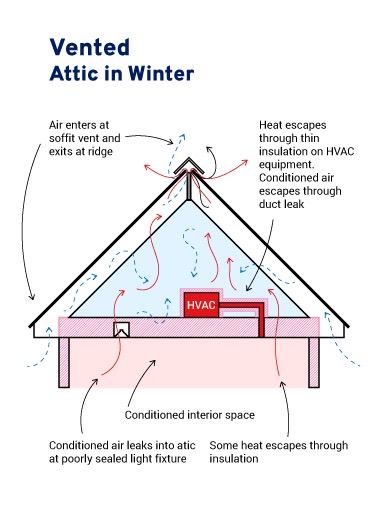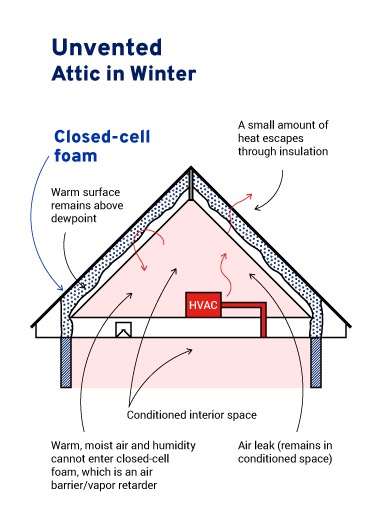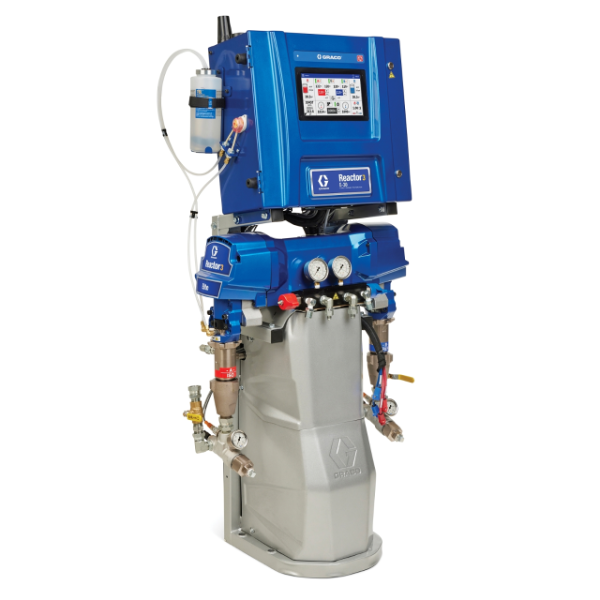Foam beats fiberglass
Lead paint, asbestos & vinyl are over – so, why choose fiberglass insulation?
Science says: Spray foam is a no‑brainer
People who built homes didn’t know better at the time, so they used lead paint to color their walls and asbestos to insulate them. Turns out there are lots of health, environmental and performance reasons not to use those materials.
The usually-pink fiberglass insulation you see in many homes was invented in the 1930s. In the 90 years since, we’ve learned there are performance issues related to coverage, air exchange, moisture and mold. These pitfalls provide more than enough reasons to switch to the modern alternative offered by science: spray foam.


What is spray foam?
Spray polyurethane foam (SPF) is a non-toxic mixture of liquid chemical ingredients that combine to create a foam-like substance that offers superior insulation properties for homes and other buildings. Once applied, the material expands quickly (to 30x its original size), completely filling even the smallest cracks or gaps. It hardens quickly to create a strong air barrier that has a measurable impact on heating and cooling bills for structures of all sizes.
Let's Get Technical: Foam vs. Fiberglass
Insulation is measured by R-value, which is a worldwide metric for measuring resistance to heat flow. The higher the R value a material has, the greater its insulating power. This is where the difference between spray foam and fiberglass begins to take shape. Here’s a chart to show you what we mean:
| MATERIAL & TYPE | DETAILS | R-VALUE |
| Fiberglass | Fiberglass batts and rolls are used in unfinished walls, including foundation walls, as well as floors and ceilings. | Range 2.2 - 3.8 |
| Sprayed Polyurethane Foam Low-Density | Low-density spray foam, also known as open-cell, is applied on walls, attics, ducts, ceilings and crawl spaces. It creates an exceptionally effective air barrier, but remains permeable to vapor and moisture. | Range: 4.4 - 8.2 |
| Sprayed Polyurethane Foam Medium-Density | Medium-density foam is often used for continuous insulation, interior wall cavity fill and unvented attic applications. It’s a closed-cell spray foam and that acts as a strong air, vapor and water barrier, and can even help reduce noise. | Range: 5.6 - 8.0 |
Quick Takes: Other Things You Should Know
Less Leaking – In and Out
Spray foam enhances the energy efficiency of residential and commercial buildings by keeping heated or cooled air from leaking out — and it keeps pollutants and allergens from leaking in through the tiny spaces you get with fiberglass insulation.
Talking Real Money Here...
According to studies by the Department of Energy and others, insulating and air sealing your home can help lower your energy bills up to 30% per year.
Tough Stuff – Extra Roof Support
Spray foam can provide additional building strength and, in some cases, reduce structural sagging that can lead to costly repairs for roofing systems.
Spend Less on HVAC Equipment
Because spray foam makes homes more energy efficient, new homes can often be fitted with smaller HVAC equipment, leading to additional savings.
Spray Foam as a Design Element?
Spray foam expands as it’s applied and seals all nooks and crannies of a home — even in hard-to-reach places. This allows for more design flexibility when you’re considering architectural features, such as domed ceilings.
Related Articles
Graco helps Isofloor taking polyurethane insulation to another level
Belgian company Isofloor has been using Graco Reactors since 2007 to spray polyurethane insulation foam on all types of floors.
Reactor E-30 makes polyurethane foam insulation affordable and easy to apply
A solution for a low cost, operator-friendly method to inject polyurethane foam into aluminium building panels helped an Egyptian manufacturer improve its processes.
Motorhome manufacturer gained efficiency with new production method
Since a long time the German motorhome and caravan manufacturer Hobby was using glass fibre to reinforce the spoilers on their motorhomes, but they were on the lookout for a change and found it in Graco’s Reactor.







